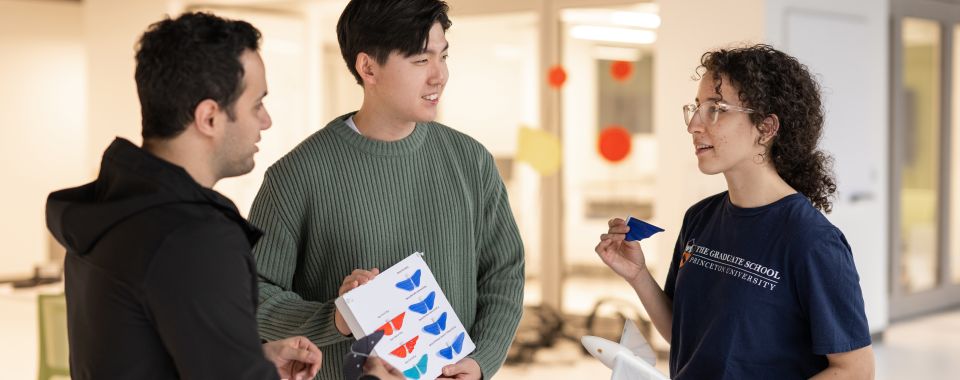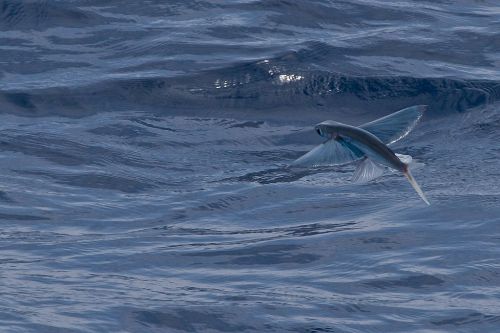
Valeria Saro-Cortes (right) in the robotics lab with fellow MAE grad students Paul Lee (center) and Ahmed Othman (left). Photo by Sameer Khan/Fotobuddy
Flying fish are a marvel of the aquatic world, capable of soaring through the air for long distances. Now their acrobatics have inspired a new approach to designing robots that could roam the open seas.
To study the mechanics of this singular feat, MAE doctoral student Valeria Saro-Cortes is designing and building a working replica from scratch. Her flexible robotic model mimics flying fish in increasingly sophisticated ways, and she uses it to measure forces and visualize flow to uncover deep truths about how these animals swim and fly.
While research on fish robotics is plentiful, little is known about the physics and biology of flying fish locomotion. Once airborne, they can glide over the waves for more than 100 feet. And they have a technique for skipping across the surface of the water and extending their flight times, enabling them to travel several hundred feet before submerging again. “It seems like it shouldn't be possible, honestly,” said Saro-Cortes. “There's no other animal that can do this type of locomotion.”

But it’s not just their aerial moves she’s interested in. Flying fish are also agile swimmers, and Saro-Cortes said agility is a big challenge for underwater robotics. Her research, advised by Aimy Wissa, assistant professor of mechanical and aerospace engineering, has two broad goals. Firstly, she wants “to understand the organism itself.” Biologists can’t closely study the movement of the live animals because flying fish require large habitats. Hence the robotic model, which not only allows them to observe locomotion but also manipulate the shape and positioning of fins. "We have engineering tools that we’re able to lend to biologists,” Saro-Cortes said.
Secondly, she wants “to extract the actual physics that we've learned from studying the fish and use these principles.” She believes she can exploit the same physics to design new kinds of vehicles. “This is an active area of research right now,” she said. “We're trying to make vehicles that are able to move through both water and air.”
To make the model, Saro-Cortes and her collaborators read existing literature on the flying fish and reviewed photos, which helped define the animal’s shape. But to perfect the shape of the fins, she went online to crowdsource images of flying fish. Ultimately, a hobbyist supplied the specific profile of the fish Saro-Cortes was looking for.
Then the team used computer-aided design software to match the model’s body to the photos. The majority of the fish model was 3D printed using polylactic acid (PLA), a kind of polyester derived from renewable sources. But Saro-Cortes found the fish would crack or break during movement. So they supplemented the PLA with a more pliable resin that works with stereolithography, a form of 3D printing that uses a light source such as a laser to cure the liquid resin.
The team used silicone for the back part of the fish model because it needs to undulate easily and provide a waterproof barrier. “A 3D printed part can't really move like that,” Saro-Cortes said. But silicone can.
The team built a few variations. The first model was static, with Saro-Cortes manually swapping fins to study how it glided in a wind tunnel, where they measured the aerodynamics including lift and drag. The team focused on the fins used for flying: pectoral fins on the sides toward the front of the fish, and pelvic fins found only on some species of flying fish just ahead of the tail. They use these pectoral and pelvic fins to swim as well, but the main propulsive mechanism through water is the caudal fin. So, for the next model — a hydrodynamics version that they could submerge for underwater research — the team built a robot featuring only the caudal fin.
Saro-Cortes said the team’s next step is to combine the two versions. “We can try to get one step closer to having an actual flying fish robot that might be able to jump out of the water and start flying, while also being able to swim. It’s kind of the dream for the robot, overall.”
But leaping, gliding piscine robots are not merely fascinating artifacts. They could be used to study marine life, including coral reefs, where soft, agile machines might be less disruptive to fragile ecosystems, according to Saro-Cortes. They would at least be more likely than humans or conventional drones to blend in with other sea creatures.
And as a bonus, their dual citizenship in sea and sky could open new possibilities for wireless communication. For any type of ocean surveying, communication underwater is very challenging, Saro-Cortes said. But “if you can have something that can not only move underwater and collect all the data but then surface and use its time in the air to communicate data to its center, then you're probably going to be able to make more efficient ocean-surveying systems.”
Saro-Cortes started working in Wissa’s Bio-Inspired Adaptive Morphology Lab at the University of Illinois Urbana-Champaign. When Wissa joined Princeton in 2022, Saro-Cortes followed. She is now the lead graduate student on the flying fish project.
“She is always looking for ways to lift others as she rises,” Wissa said, pointing out that several former undergraduate mentees have attributed “their love of research and decision to attend graduate school to Valeria’s mentorship.”
Saro-Cortes attributes her own drive to early mentorship experiences that connected her to her passions. She had always loved watching science documentaries, especially films that about unusual prehistoric animals and how they moved and walked. Then, as an undergraduate, she spent a summer at the University of Pennsylvania studying fluid mechanics as part of the National Science Foundation’s Research Experiences for Undergraduates (REU) fellowship program. “That was the clincher,” she said. Fluid mechanics and animal locomotion. “It combined two very raw interests of mine.”